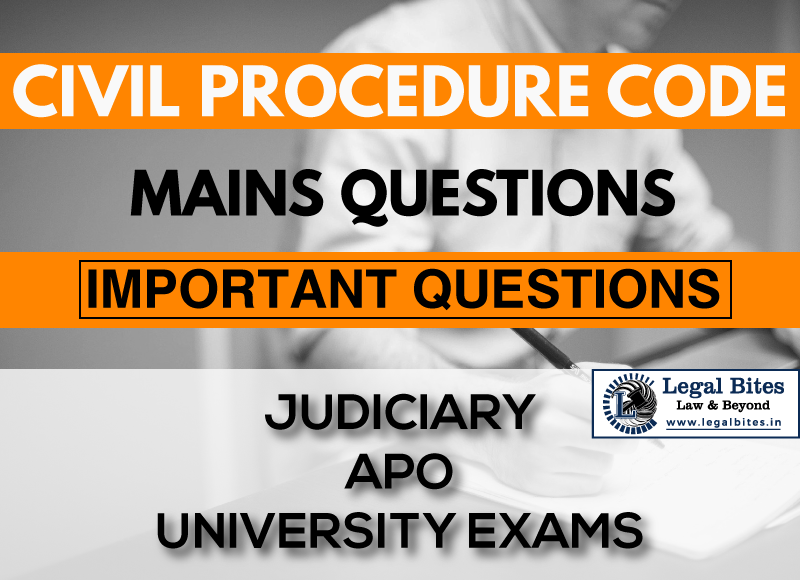'A' lets a house to 'B’ at a yearly rent Rs. 12,000. The rent for the years 1980, 1981 and 1982 is due and unpaid. ‘A’ sues 'Bin 1983 only for rent due in 1981. Can A afterwards sue ‘B’ for the rent due for 1980 and 1982?
Find the answer to the mains question only on Legal Bites.

Question: 'A’ lets a house to 'B’ at a yearly rent Rs. 12,000. The rent for the years 1980, 1981 and 1982 is due and unpaid. ‘A’ sues 'Bin 1983 only for rent due in 1981. Can A afterwards sue ‘B’ for the rent due for 1980 and 1982? [WB J.S. 1993]Find the answer to the mains question only on Legal Bites. [ 'A’ lets a house to 'B’ at a yearly rent Rs. 12,000. The rent for the years 1980, 1981 and 1982 is due and unpaid. ‘A’ sues 'Bin 1983 only for rent due in 1981. Can...
Question: 'A’ lets a house to 'B’ at a yearly rent Rs. 12,000. The rent for the years 1980, 1981 and 1982 is due and unpaid. ‘A’ sues 'Bin 1983 only for rent due in 1981. Can A afterwards sue ‘B’ for the rent due for 1980 and 1982? [WB J.S. 1993]
Find the answer to the mains question only on Legal Bites. [ 'A’ lets a house to 'B’ at a yearly rent Rs. 12,000. The rent for the years 1980, 1981 and 1982 is due and unpaid. ‘A’ sues 'Bin 1983 only for rent due in 1981. Can A afterwards sue ‘B’ for the rent due for 1980 and 1982?]
Answer
Order 2 of C.P.C. deals with 'Frame of Suit'. Order 2, Rule 2 on which this problem is based reads as follows:-
"Every suit shall include the whole of the claim which the plaintiff is entitled to make in respect of the cause of action; but a plaintiff may relinquish any portion of his claim in order to bring the suit within the jurisdiction of any court-Sub-rule 1 of Rule 2 of Order 2 (Suit to include the whole claim)."
Where a plaintiff omits to sue in respect of, or intentionally relinquish, any portion of his claim, he shall not afterwards sue in respect of the portion so omitted or relinquished-Sub-rule 2 of Rule 2 of Order 2 (Relinquishment of part of claim).
A person entitled to more than one relief in respect of the same cause of action may sue for all or any of such reliefs: but if he omits, except with the leave of the court, to sue for all such reliefs, he shall not afterwards sue for any relief so omitted"-Sub-rule 3 of Rule 2 of Order 2 (Omission to sue for one of several reliefs).
Based on this illustration, the situation involves a landlord (A) letting a house to a tenant (B) at an annual rent of Rs. 12,000. The rent for the years 1980, 1981, and 1982 is unpaid, and in 1983, the landlord decides to sue the tenant specifically for the rent due in 1981.
In this case, the Code of Civil Procedure, particularly Order 2, Rule 2, comes into play. As per Order 2, Rule 2, a plaintiff is generally required to include the whole of their claim in one suit. This means that if a plaintiff has multiple claims arising out of a single cause of action, they should present all those claims in a single lawsuit.
However, in the given illustration, the landlord only sues the tenant for the rent due in 1981 and excludes the rent for 1980 and 1982. This means that the landlord has split their claim by pursuing only a part of the total rent due.
As a result, the Code of Civil Procedure, Order 2, Rule 2 would prevent the landlord from subsequently suing the tenant for the rent due in 1980 and 1982. Once the landlord has chosen to sue for a specific portion of the rent in a separate suit, they cannot initiate another suit to recover the remaining rent.
Therefore, based on the illustration and the principles of Order 2, Rule 2, the landlord (A) would be barred from suing the tenant (B) for the rent due in 1980 and 1982 after having already pursued a separate suit for the rent due in 1981.
Important Mains Questions Series for Judiciary, APO & University Exams
- CPC Mains Questions Series: Important Questions Part – I of X
- CPC Mains Questions Series: Important Questions Part – II of X
- CPC Mains Questions Series: Important Questions Part – III of X
- CPC Mains Questions Series: Important Questions Part – IV of X
- CPC Mains Questions Series: Important Questions Part – V of X
- CPC Mains Questions Series: Important Questions Part – VI of X
- CPC Mains Questions Series: Important Questions Part – VII of X
- CPC Mains Questions Series: Important Questions Part – VIII of X
- CPC Mains Questions Series: Important Questions Part – IX of X
- CPC Mains Questions Series: Important Questions Part – X of X

Mayank Shekhar
Mayank is an alumnus of the prestigious Faculty of Law, Delhi University. Under his leadership, Legal Bites has been researching and developing resources through blogging, educational resources, competitions, and seminars.
